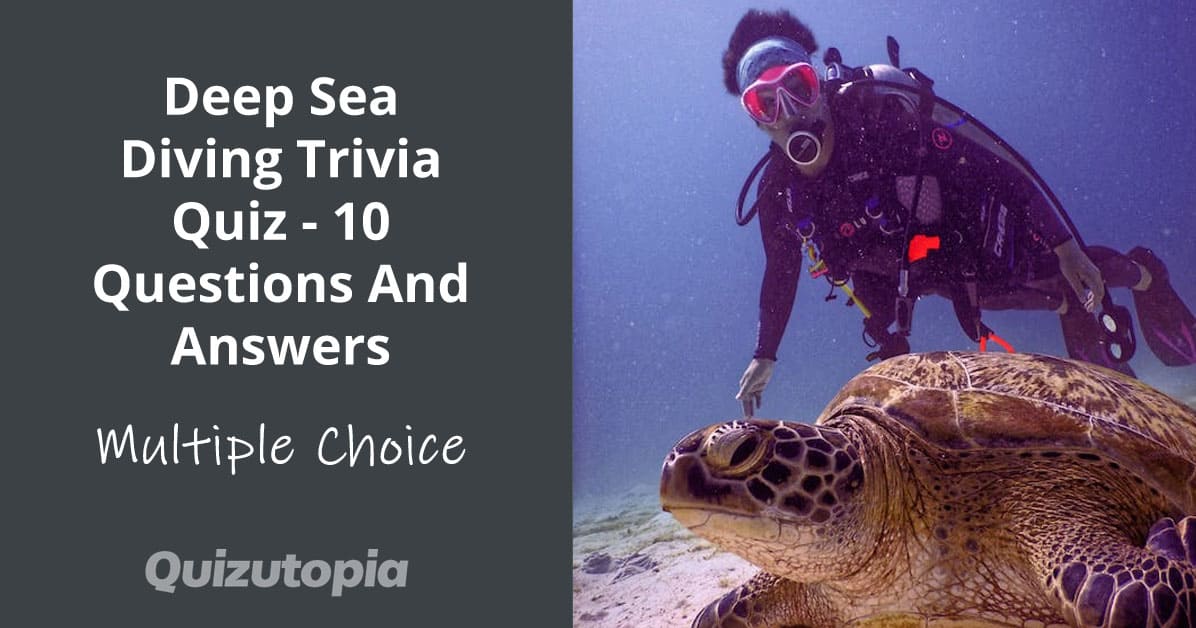Get ready to plunge into the mysterious depths of the ocean with our thrilling Deep Sea Diving Trivia Quiz! Strap on your virtual scuba gear and prepare to explore the wonders of the underwater world as we challenge your knowledge of this exhilarating sport.
From the fascinating creatures that inhabit the ocean floor to the mind-boggling depths that humans have reached, this quiz will put your aquatic expertise to the ultimate test. With 10 captivating questions and answers, you’ll uncover hidden gems of information about the brave divers who venture into the abyss and the incredible discoveries they’ve made.
So, take a deep breath, adjust your oxygen tank, and get ready for an immersive journey into the world of deep-sea diving!

Subscribe to our mailing list to receive FREE exclusive quizzes and offers!
- What is the deepest part of the ocean called?
- Tonga Trench
- Mariana Trench
- Sirena Deep
- Challenger Deep
The correct answer is Mariana Trench.
The Mariana Trench is the deepest part of the ocean, reaching a depth of about 36,070 feet (10,994 meters). - What gas mixture is commonly used in deep-sea diving to prevent nitrogen narcosis?
- Nitrox
- Trimix
- Heliox
- Oxygen
The correct answer is Trimix.
Trimix is a gas mixture containing oxygen, nitrogen, and helium, which helps prevent nitrogen narcosis and oxygen toxicity during deep dives. - Which deep-sea diving pioneer invented the Aqua-Lung?
- Edmond Hillary
- Jacques Cousteau
- Robert Boyle
- Lionel Crabb
The correct answer is Jacques Cousteau.
Jacques Cousteau, a French naval officer, explorer, and filmmaker, invented the Aqua-Lung, an early version of the modern scuba system. - What is the maximum depth a recreational scuba diver should dive without specialized training?
- 130 feet (40 meters)
- 100 feet (30 meters)
- 330 feet (100 meters)
- 200 feet (60 meters)
The correct answer is 130 feet (40 meters).
Recreational scuba divers should not dive deeper than 130 feet (40 meters) without specialized training, as the risks and complications increase significantly beyond this depth.
- What is the name of the pressure-related illness that deep-sea divers can experience?
- Oxygen toxicity
- Nitrogen narcosis
- Barotrauma
- Decompression sickness
The correct answer is Decompression sickness.
Decompression sickness, also known as “the bends,” is a potentially life-threatening condition caused by the formation of nitrogen bubbles in the body due to rapid pressure changes during ascent. - Which ocean animal is known for its ability to produce light through bioluminescence?
- Giant squid
- Anglerfish
- Vampire squid
- Goblin shark
The correct answer is Anglerfish.
Anglerfish are deep-sea fish that can produce light through bioluminescence, using a specialized organ called the esca to lure prey. - What is the name of the research submersible that reached the bottom of the Mariana Trench in 1960?
- Nautile
- Alvin
- Deepsea Challenger
- Trieste
The correct answer is Trieste.
The Trieste, a Swiss-designed research submersible, reached the bottom of the Mariana Trench in 1960, marking the first time humans had reached the deepest part of the ocean. - What is the main purpose of a diving bell?
- To provide a temporary air pocket for divers
- To measure depth
- To increase buoyancy
- To assist with decompression
The correct answer is to provide a temporary air pocket for divers.
A diving bell is a rigid chamber that traps air inside, allowing divers to access a temporary air pocket underwater for rest or to switch out equipment. - Which of these is not a type of underwater habitat used by deep-sea divers?
- Saturation system
- Oceanarium
- SEALAB
- Aquarius Reef Base
The correct answer is Oceanarium.
An oceanarium is actually a marine mammal park or aquarium, while saturation systems, Aquarius Reef Base, and SEALAB are all types of underwater habitats used by deep-sea divers for research and exploration. - What is the primary purpose of a rebreather in deep-sea diving?
- To recycle exhaled gas
- To regulate gas mixtures
- To provide additional buoyancy
- To filter out contaminants
The correct answer is to recycle exhaled gas.
A rebreather is a type of breathing apparatus that recycles exhaled gas, removing carbon dioxide and adding oxygen, allowing divers to conserve gas and extend their dive time.









